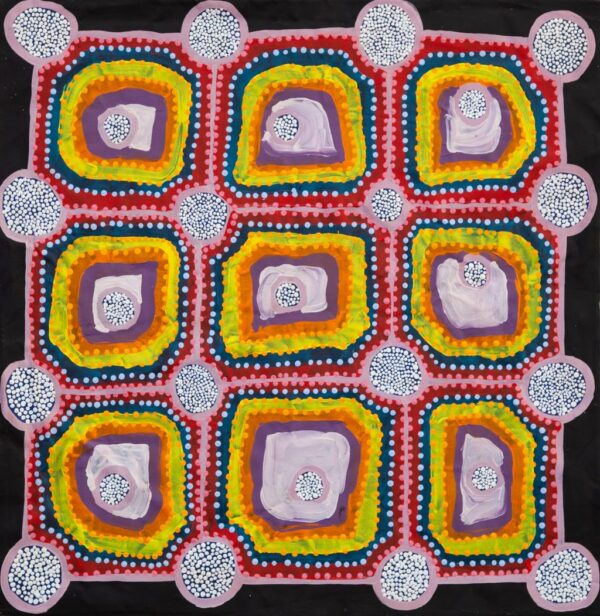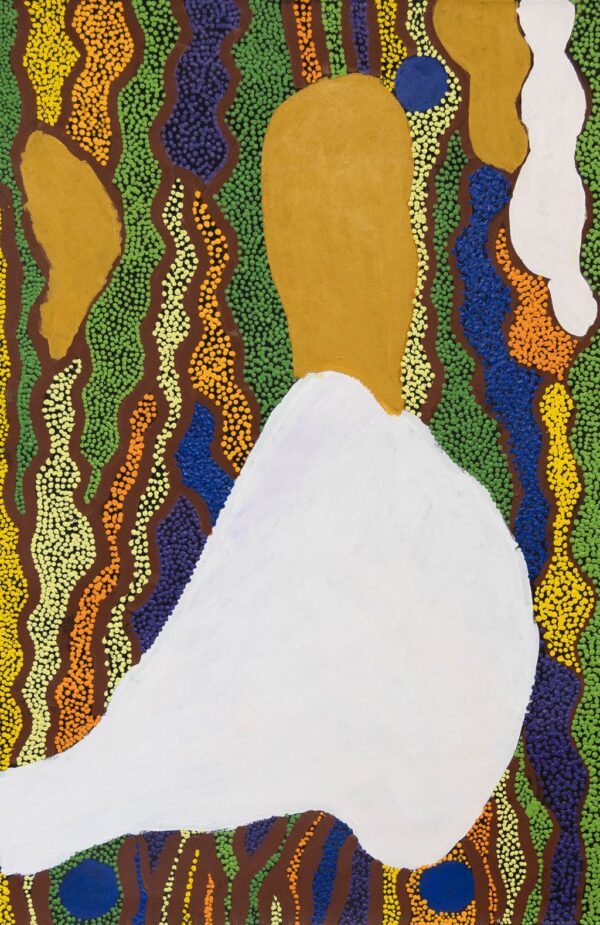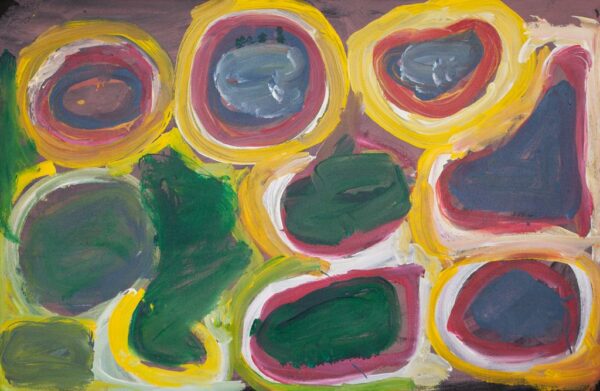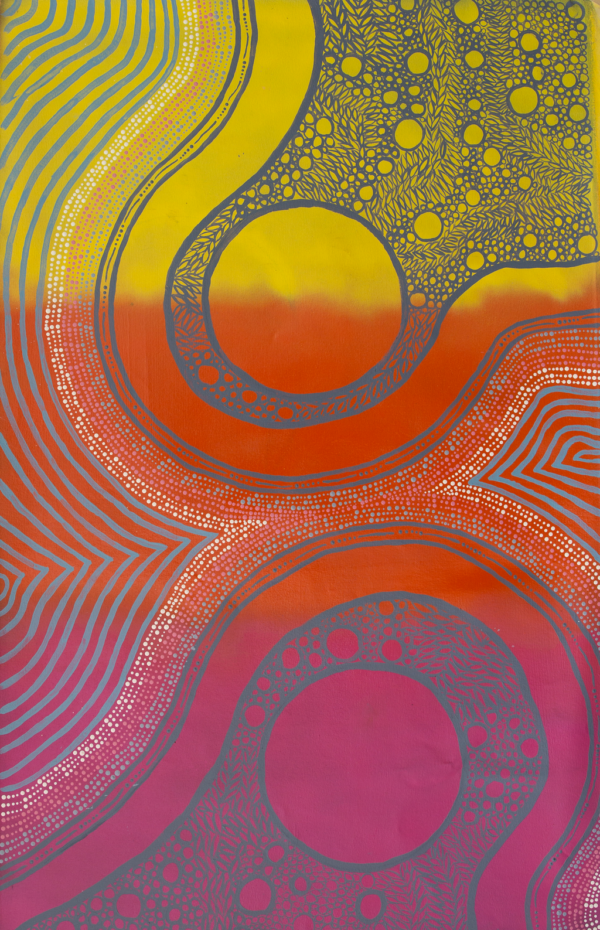$1,000.00 Original price was: $1,000.00.$600.00Current price is: $600.00.
1 in stock
Tanya Charles
61 x 91 cm: acrylic on canvas
Year: 2022
22-1587
Minyipuru (Jakulyukulyu, Seven Sisters)
The term Jukurrpa is often translated in English as the ‘dreaming’, or ‘dreamtime’. It refers generally to the period in which the world was created by ancestral beings, who assumed both human and nonhuman forms. These beings shaped what had been a formless landscape; creating waters, plants, animals, and people. At the same time they provided cultural protocols for the people they created, as well as rules for interacting with the natural environment. At their journey’s end, the ancestral beings transformed themselves into important waters, hills, rocks, and even constellations.
The story of the Minyipuru, or Jakulyukulyu (Seven Sisters) begins in the Country around Roebourne on the west coast of Western Australia. When they began travelling east on their long journey they were many more than seven; sisters, mothers, and children. At various places on their journey, throughout which they are pursued by a lustful old man, Yurla, the Minyipuru lose members of their group until eventually only seven sisters remained. There are many variations of the Minyipuru Jukurrpa. Here, the Martu version is chronicled.
From Roebourne, the Minyipuru travelled close to Parnngurr, where an important event took place in women’s law and some of the sisters had separated from the others as they fled in panic from Yurla. At Parnngurr, the Minyipuru sat down to rest on top of a hill overlooking present day Parnngurr community. From Parnngurr the women travelled to Kaalpa (Kalypa, Canning Stock Route Well 23), where they met a group of men. It was the first time either group had seen members of the opposite sex. The men tried to grab the women, but the Minyipuru chased them, hitting them with their wana (digging sticks) and leaving them lying there.
The Minyipuru danced as they continued their journey to Kartarru (Canning Stock Route Well 24), and then Yurrunguny, east of Warla-warla (Canning Stock Route Well 31), where they encountered the Niminjarra, spiritual ancestors of the Warnman people. The Niminjarra were looking for the wives of the Nganyangu men, who eventually became bodyguards at Kumpupirntily, protecting people from Ngayurnangalku cannibal people.
From Yurrunguny the women walked to Mungurlyi and then they flew to Nyipily (Nibil, Canning Stock Route Well 34), where they heard the sound of Kinyu howling and a women’s song, ‘Wulkartungara’. From Nyipily the Minyipuru flew to Yanjiwarra jurnu (soakwaters) and danced there. Near the mulunturu (desert oaks) here they left the mark of their dancing. Some of the Minyipuru can be seen today as a group of trees between Nyipil and Kunawarritji.
The Minyipuru then flew to Pangkapirni, between Canning Stock Route Wells 35 and 36, where Yurla, who had been following them the entire time, finally caught up with them. The women watched him sleep and when he woke up he grabbed one of them and forcibly slept with her. The other women tried to help their sister escape, but they couldn’t free her. They promised that they would stay with Yurla and made him collect wood for them. They teased him, saying “Come and get us!”, and he began to sing a man’s song and ran away happy; his heart was beating fast. However, the Minyipuru were tricking Yurla and instead hid from him, floating in the air in a long line while he ran around trying to find their tracks. Finally they made a kumpu (urinated) on his face, until he couldn’t see anything at all, and only then they were able to free their sister. Yurla couldn’t see anything, but he could hear the Minyipuru giggling and laughing above him. He fetched a jannga (ladder) and tried to reach them, but they just floated higher and then pushed the ladder over when he got too close. He eventually tired and fell down, crawling on his stomach. He crawled a long way and then slept, and while he was asleep, the Minyipuru all flew away. They next arrived close to Lipuru (Canning Stock Route Well 37), where Yurla again caught up to them and tried to grab five of the women.
Other sites within Martu Country where the Minyipuru travelled include Warntili claypan (near Canning Stock Route Well 25), Tiwa (Canning Stock Route Well 26), Juntu-juntu (Canning Stock Route Well 30), Natawalu (Canning Stock Route Well 40), and then adjacent sites north of the Karlamily River Region; Kukulyurru, Juntiwa and Pangkal, where several of the sisters remain as rocks today. The Minyipuru continued to flee far to the east and beyond Martu Country, stopping at various sites through central and South Australia.




Sign up to Martumili Artists’ mailing list to receive artist news, special offers, and shop updates.




Martumili Artists warns visitors that our website includes images and artworks of Artists who have passed away which may cause distress to some Indigenous people.
Martumili Artists acknowledges the Nyiyaparli and Martu people as the Traditional Owners of the land we live and work on. We also acknowledge the Traditional Owners throughout our country and our Elders; past, present and emerging.